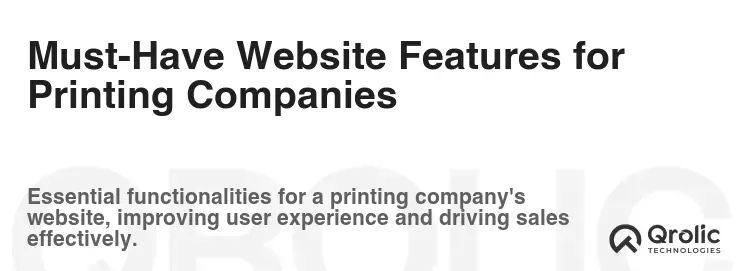Quick Summary:
- Create a stunning, mobile-friendly, and easy-to-use website.
- Offer detailed product showcases and simple custom ordering.
- Boost visibility with SEO, content, and social media.
- Ensure secure transactions and provide excellent customer support.
Table of Contents
- Must-Have Website Features for Printing Companies
- 1. A Stunning and User-Friendly Design: The First Impression Matters
- 2. Comprehensive Product Showcase: Display Your Printing Expertise
- 3. Custom Order Forms: Simplify the Ordering Process
- 4. Online Proofing System: Ensuring Accuracy and Satisfaction
- 5. Blog and Content Marketing: Establishing Expertise and Driving Traffic
- 6. Customer Account Management: Enhancing Customer Loyalty
- 7. Integration with Social Media: Expanding Your Reach
- 8. Live Chat Support: Providing Instant Assistance
- 9. Search Engine Optimization (SEO): Driving Organic Traffic
- 10. Analytics and Tracking: Measuring Performance and Making Improvements
- 11. Secure Payment Gateway: Ensuring Safe Transactions
- 12. Testimonials and Case Studies: Building Trust and Credibility
- 13. ADA Compliance: Ensuring Accessibility for All
- 14. Multi-Language Support: Reaching a Wider Audience
- 15. Website Security: Protecting Your Business and Customers
- 16. Qrolic Technologies: Your Partner in Digital Transformation
- Conclusion: Building a Printing Website for the Future
Must-Have Website Features for Printing Companies

The printing industry is a competitive landscape. To thrive, your printing company needs a website that’s more than just an online brochure; it needs to be a powerful lead generation machine, a customer service portal, and a brand-building platform all rolled into one. In this comprehensive guide, we’ll delve into the must-have website features that will empower your printing company to stand out, attract more business, and streamline operations. Forget outdated static pages; let’s build a dynamic online presence that delivers results.
1. A Stunning and User-Friendly Design: The First Impression Matters
Why it’s Crucial: Your website design is the digital equivalent of your storefront. It’s the first thing potential customers see, and it profoundly impacts their perception of your brand. A poorly designed website can instantly deter visitors, while a visually appealing and user-friendly design can captivate them and encourage exploration.
How to achieve it:
- Clean and Modern Aesthetics: Ditch the cluttered layouts and embrace a minimalist approach. Use plenty of white space, clear typography, and high-quality images to create a visually appealing experience.
- Intuitive Navigation: Ensure visitors can easily find what they’re looking for. Implement a clear and concise navigation menu, a prominent search bar, and well-organized content categories.
- Mobile-First Design: In today’s mobile-dominated world, your website must be responsive and optimized for all devices, from smartphones to tablets. Prioritize a mobile-first approach to ensure a seamless experience for mobile users. This also factors heavily in Google’s ranking algorithm.
- Brand Consistency: Maintain a consistent brand identity throughout your website, using your logo, colors, and fonts to reinforce your brand message and create a cohesive look and feel.
- Fast Loading Speed: Slow loading times can frustrate visitors and negatively impact your search engine rankings. Optimize images, leverage browser caching, and use a content delivery network (CDN) to improve website performance.
Example: Imagine a printing company specializing in high-end brochures. Their website should showcase examples of their best work prominently, using high-resolution images and a visually appealing layout that reflects the quality of their services.
2. Comprehensive Product Showcase: Display Your Printing Expertise
Why it’s Crucial: Your product showcase is the heart of your website for printing companies. It’s where you demonstrate your capabilities, highlight your expertise, and entice customers to place orders. A well-crafted product showcase should be informative, visually engaging, and easy to navigate.
How to achieve it:
- Detailed Product Descriptions: Provide comprehensive descriptions for each product, including sizes, paper stocks, finishing options, and available quantities. Be specific and informative to address customer queries upfront.
- High-Quality Images and Videos: Use professional-quality images and videos to showcase your products in their best light. Offer multiple angles and zoom capabilities to allow customers to examine the details.
- Categorization and Filtering: Organize your products into logical categories and implement robust filtering options to help customers quickly find what they’re looking for. Filters can include paper type, size, color, finishing options, and more.
- Pricing Information: Clearly display pricing information for each product, including volume discounts and customization options. Transparency builds trust and simplifies the ordering process.
- Customer Reviews and Testimonials: Showcase positive customer reviews and testimonials to build credibility and social proof. Encourage satisfied customers to leave reviews on your website.
Keywords to Integrate: Business Cards, Brochures, Flyers, Posters, Banners, Stickers, Labels, Packaging, Custom Printing, Digital Printing, Offset Printing, Large Format Printing.
Example: A printing company offering business cards should provide detailed information about paper stock options (e.g., matte, gloss, linen), finishing options (e.g., rounded corners, foil stamping), and available sizes. They should also showcase examples of different business card designs to inspire customers.
3. Custom Order Forms: Simplify the Ordering Process
Why it’s Crucial: Streamlining the ordering process is essential for converting website visitors into paying customers. Custom order forms make it easy for customers to specify their requirements, upload files, and request quotes, all within a user-friendly interface.
How to achieve it:
- User-Friendly Interface: Design your order forms with a clear and intuitive interface that guides customers through the process step-by-step. Use clear labels, instructions, and progress indicators.
- File Upload Functionality: Implement a secure and reliable file upload system that allows customers to easily upload their artwork files in various formats (e.g., PDF, AI, PSD).
- Customization Options: Offer a wide range of customization options, such as size, paper stock, color, finishing, and quantity. Allow customers to specify their exact requirements for each product.
- Real-Time Quoting: Integrate a real-time quoting system that instantly calculates the price based on the customer’s specifications. This eliminates the need for manual quoting and speeds up the ordering process.
- Order Tracking: Provide customers with the ability to track the status of their orders online. This enhances transparency and builds trust.
Keywords to Integrate: Custom Printing, Online Printing, Print Order Form, Upload Artwork, Get a Quote, Printing Services.
Example: A printing company offering custom banners should have an order form that allows customers to specify the banner size, material (e.g., vinyl, mesh), finishing options (e.g., grommets, hemming), and upload their artwork. The form should also provide an instant price quote based on the selected options.
4. Online Proofing System: Ensuring Accuracy and Satisfaction
Why it’s Crucial: An online proofing system allows customers to review and approve their artwork before it goes to print. This helps to prevent errors, reduce waste, and ensure customer satisfaction.
How to achieve it:
- High-Resolution Proofing: Provide customers with high-resolution proofs that accurately represent the final printed product.
- Annotation Tools: Offer annotation tools that allow customers to mark up the proofs and provide feedback on specific areas.
- Version Control: Implement version control to track changes and ensure that the correct version of the artwork is approved for printing.
- Automated Notifications: Send automated email notifications to customers when their proofs are ready for review and when their orders are approved for printing.
- Integration with Production Workflow: Seamlessly integrate the online proofing system with your production workflow to streamline the printing process.
Example: A customer ordering business cards should be able to review a high-resolution proof online, zoom in to examine the details, and use annotation tools to request changes to the text or layout.
5. Blog and Content Marketing: Establishing Expertise and Driving Traffic
Why it’s Crucial: A blog is a powerful tool for establishing your printing company as a thought leader in the industry, attracting organic traffic to your website, and generating leads. By creating valuable and informative content, you can educate your audience, build trust, and position yourself as a trusted advisor.
How to achieve it:
- Keyword Research: Conduct thorough keyword research to identify the topics that your target audience is searching for.
- High-Quality Content: Create high-quality, informative, and engaging content that addresses the needs and interests of your target audience.
- Variety of Content Formats: Use a variety of content formats, such as blog posts, articles, infographics, videos, and case studies.
- SEO Optimization: Optimize your blog content for search engines by using relevant keywords, meta descriptions, and internal links.
- Promotion and Distribution: Promote your blog content on social media, email marketing, and other channels to reach a wider audience.
Keywords to Integrate: Printing Tips, Design Tips, Marketing Materials, Paper Stocks, Finishing Options, Printing Industry News.
Example Blog Post Topics:
- “The Ultimate Guide to Choosing the Right Paper Stock for Your Business Cards”
- “5 Design Tips to Create a Brochure That Converts”
- “How to Use Print Marketing to Boost Your Sales”
- “The Latest Trends in Packaging Design”
6. Customer Account Management: Enhancing Customer Loyalty
Why it’s Crucial: A customer account management system allows customers to easily manage their orders, track their order history, save their artwork files, and update their contact information. This enhances customer loyalty and encourages repeat business.
How to achieve it:
- Secure Login: Provide a secure login system that protects customer data.
- Order History: Allow customers to view their past orders and track the status of their current orders.
- Artwork Storage: Provide a secure storage space for customers to save their artwork files for future use.
- Address Book: Allow customers to save multiple shipping addresses.
- Communication Preferences: Allow customers to manage their email and communication preferences.
Example: A customer should be able to log into their account, view their previous orders for business cards, download their artwork files, and update their shipping address.
7. Integration with Social Media: Expanding Your Reach
Why it’s Crucial: Social media is a powerful tool for promoting your printing company, engaging with your audience, and driving traffic to your website. Integrating your website with social media allows you to easily share content, promote products, and connect with potential customers.
How to achieve it:
- Social Sharing Buttons: Add social sharing buttons to your website to allow visitors to easily share your content on their social media channels.
- Social Media Feeds: Embed your social media feeds on your website to showcase your latest posts and updates.
- Social Login: Allow visitors to log in to your website using their social media accounts.
- Social Advertising: Use social media advertising to target potential customers based on their demographics, interests, and behaviors.
Platforms to Focus On: Facebook, Instagram, LinkedIn, Pinterest.
Example: Integrate a Facebook feed on your website showcasing customer testimonials and recent printing projects.
8. Live Chat Support: Providing Instant Assistance
Why it’s Crucial: Live chat support provides instant assistance to website visitors who have questions or need help with their orders. This can significantly improve customer satisfaction and increase conversion rates.
How to achieve it:
- 24/7 Availability: Provide live chat support 24 hours a day, 7 days a week.
- Knowledgeable Agents: Train your live chat agents to be knowledgeable about your products and services.
- Personalized Service: Provide personalized service to each customer and address their specific needs.
- Proactive Chat: Initiate chat sessions with website visitors who appear to be struggling or have questions.
- Integration with CRM: Integrate your live chat system with your CRM to track customer interactions and improve service quality.
Example: A visitor who is having trouble uploading their artwork file should be able to initiate a live chat session and receive immediate assistance from a support agent.
9. Search Engine Optimization (SEO): Driving Organic Traffic
Why it’s Crucial: SEO is the process of optimizing your website to rank higher in search engine results pages (SERPs). This is essential for driving organic traffic to your website and attracting potential customers who are actively searching for printing services.
How to achieve it:
- Keyword Research: Conduct thorough keyword research to identify the keywords that your target audience is searching for.
- On-Page Optimization: Optimize your website content, meta descriptions, and title tags for relevant keywords.
- Off-Page Optimization: Build high-quality backlinks from reputable websites to improve your website’s authority and credibility.
- Technical SEO: Ensure that your website is technically sound, with fast loading speeds, mobile-friendliness, and a clean URL structure.
- Content Marketing: Create valuable and informative content that attracts and engages your target audience.
Keywords to Focus On: Printing Services, Online Printing, Custom Printing, Business Cards, Brochures, Flyers, Posters, Banners, Stickers, Labels, Packaging.
Example: Optimize your website’s homepage for the keyword “printing services near me” to attract local customers who are searching for printing companies in your area.
10. Analytics and Tracking: Measuring Performance and Making Improvements
Why it’s Crucial: Analytics and tracking tools allow you to measure the performance of your website and identify areas for improvement. By tracking key metrics, such as website traffic, conversion rates, and bounce rates, you can gain valuable insights into your audience’s behavior and optimize your website for better results.
How to achieve it:
- Google Analytics: Install Google Analytics on your website to track website traffic, user behavior, and conversion rates.
- Google Search Console: Use Google Search Console to monitor your website’s performance in Google search results.
- Heatmaps and Session Recordings: Use heatmaps and session recordings to visualize how users interact with your website and identify areas where they are getting stuck.
- A/B Testing: Use A/B testing to experiment with different website designs and content to see what performs best.
- Regular Reporting: Generate regular reports on your website’s performance and use the data to make informed decisions about your marketing strategy.
Key Metrics to Track: Website Traffic, Bounce Rate, Conversion Rate, Average Session Duration, Pages Per Session, Top Landing Pages, Top Exit Pages, Keyword Rankings.
Example: Track the conversion rate of your custom order form to see how many website visitors are actually placing orders. If the conversion rate is low, you can experiment with different form designs and content to improve its effectiveness.
11. Secure Payment Gateway: Ensuring Safe Transactions
Why it’s Crucial: A secure payment gateway is essential for protecting your customers’ financial information and ensuring safe online transactions. This builds trust and encourages customers to complete their orders.
How to achieve it:
- SSL Certificate: Install an SSL certificate on your website to encrypt all data transmitted between your website and your customers’ browsers.
- PCI Compliance: Ensure that your payment gateway is PCI compliant to meet the industry standards for data security.
- Fraud Prevention: Implement fraud prevention measures to protect your business from fraudulent transactions.
- Multiple Payment Options: Offer multiple payment options, such as credit cards, debit cards, and PayPal, to cater to a wider range of customers.
- Clear Payment Policies: Clearly communicate your payment policies to customers, including refund policies and security measures.
Popular Payment Gateways: Stripe, PayPal, Authorize.net.
Example: Display security badges and logos on your checkout page to reassure customers that their financial information is protected.
12. Testimonials and Case Studies: Building Trust and Credibility
Why it’s Crucial: Testimonials and case studies are powerful tools for building trust and credibility with potential customers. By showcasing positive feedback from satisfied customers, you can demonstrate the value of your printing services and convince potential customers to choose your company.
How to achieve it:
- Gather Testimonials: Request testimonials from satisfied customers and feature them prominently on your website.
- Create Case Studies: Develop detailed case studies that highlight the specific challenges you helped your customers overcome and the results you achieved.
- Use Real Names and Photos: Use real names and photos of your customers to make your testimonials and case studies more authentic.
- Focus on Benefits: Focus on the benefits that your customers have experienced as a result of using your printing services.
- Update Regularly: Regularly update your testimonials and case studies to keep them fresh and relevant.
Example: Showcase a case study that highlights how you helped a local business design and print a marketing brochure that increased their sales by 20%.
13. ADA Compliance: Ensuring Accessibility for All
Why it’s Crucial: ADA compliance (Americans with Disabilities Act) ensures that your website is accessible to people with disabilities. This is not only a legal requirement but also a moral obligation.
How to achieve it:
- Use Alt Text for Images: Provide descriptive alt text for all images on your website.
- Provide Captions for Videos: Provide captions for all videos on your website.
- Use Proper Heading Structure: Use proper heading structure to organize your content.
- Ensure Keyboard Navigation: Ensure that your website can be easily navigated using a keyboard.
- Use Sufficient Color Contrast: Use sufficient color contrast between text and background.
- Use Accessible Forms: Use accessible forms that are easy to fill out.
- Test with Assistive Technologies: Test your website with assistive technologies, such as screen readers, to ensure that it is accessible to people with disabilities.
Tools for ADA Compliance: WAVE Web Accessibility Evaluation Tool, Accessibility Insights.
Example: Ensure that all images on your website have descriptive alt text that accurately describes the image content.
14. Multi-Language Support: Reaching a Wider Audience
Why it’s Crucial: If you serve customers in multiple languages, offering multi-language support on your website is essential for reaching a wider audience and providing a better user experience.
How to achieve it:
- Translate Your Website Content: Translate all of your website content into the languages that your target audience speaks.
- Use a Language Switcher: Implement a language switcher that allows visitors to easily select their preferred language.
- Use hreflang Tags: Use hreflang tags to tell search engines which language each page of your website is in.
- Use a Multilingual CMS: Use a multilingual CMS (Content Management System) to easily manage your website content in multiple languages.
Popular Multilingual CMS Platforms: wordpress with WPML, Drupal, Joomla.
Example: Offer your website in English and Spanish to cater to customers in both the United States and Latin America.
15. Website Security: Protecting Your Business and Customers
Why it’s Crucial: Website security is paramount for protecting your business and your customers from cyber threats, such as hacking, malware, and data breaches.
How to achieve it:
- Use a Strong Password: Use a strong password for your website administrator account.
- Keep Your Software Up-to-Date: Keep your website software, including your CMS and plugins, up-to-date with the latest security patches.
- Install a Security Plugin: Install a security plugin to protect your website from malware and hacking attempts.
- Use a Web Application Firewall (WAF): Use a WAF to protect your website from malicious traffic.
- Regularly Back Up Your Website: Regularly back up your website to protect your data in case of a security breach.
- Monitor Your Website for Security Threats: Monitor your website for security threats and take immediate action to address any vulnerabilities.
Popular Security Plugins: Sucuri Security, Wordfence Security.
Example: Regularly back up your website to an offsite location to protect your data in case of a server failure or security breach.
16. Qrolic Technologies: Your Partner in Digital Transformation
Qrolic Technologies (https://qrolic.com/) is a leading provider of innovative digital solutions that empower businesses to thrive in the modern digital landscape. We specialize in helping printing companies like yours leverage technology to streamline operations, enhance customer experiences, and drive growth.
How Qrolic Technologies Can Help Your Printing Company:
- Website Design and Development: We create stunning and user-friendly websites that showcase your printing expertise and attract more business.
- Custom Software Development: We develop custom software solutions tailored to your specific needs, such as order management systems, online proofing tools, and workflow automation systems.
- E-Commerce Solutions: We help you build and optimize your online store to sell your printing services directly to customers.
- Digital Marketing Services: We provide comprehensive digital marketing services, including SEO, PPC, and social media marketing, to drive traffic to your website and generate leads.
- Cloud Computing Solutions: We help you migrate your IT infrastructure to the cloud to improve efficiency, reduce costs, and enhance scalability.
- Mobile App Development: We develop mobile apps that allow your customers to easily place orders, track their order status, and communicate with your team.
Why Choose Qrolic Technologies?
- Expertise in the Printing Industry: We have a deep understanding of the printing industry and the unique challenges that printing companies face.
- Customized Solutions: We provide customized solutions tailored to your specific needs and goals.
- Experienced Team: We have a team of experienced developers, designers, and marketers who are passionate about helping businesses succeed.
- Results-Driven Approach: We are focused on delivering results that help you achieve your business objectives.
- Commitment to Customer Satisfaction: We are committed to providing exceptional customer service and support.
Contact Qrolic Technologies today to learn how we can help you transform your printing company into a digital powerhouse.
Conclusion: Building a Printing Website for the Future
In the competitive world of printing, a robust and feature-rich website is no longer a luxury but a necessity. By implementing the must-have features outlined in this guide, you can create a powerful online presence that attracts new customers, streamlines operations, and positions your printing company for long-term success. From stunning design and comprehensive product showcases to custom order forms and secure payment gateways, each feature plays a crucial role in delivering an exceptional user experience and driving business growth. Remember to prioritize user-friendliness, mobile optimization, and ADA compliance to ensure that your website is accessible to everyone. And don’t forget to leverage the expertise of companies like Qrolic Technologies to take your digital transformation to the next level. By embracing these strategies, you can build a printing website that not only meets the needs of your customers but also sets you apart from the competition and propels your business into the future.







